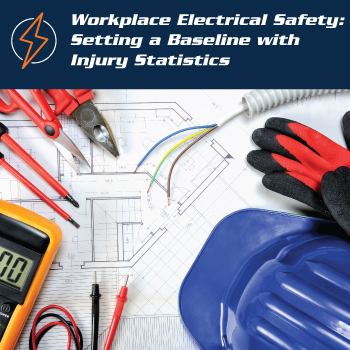We use cookies to make your experience better. To comply with the new e-Privacy directive, we need to ask for your consent to set the cookies. Learn more.
Workplace Electrical Safety: Setting a Baseline with Injury Statistics
In honor of National Electrical Safety Month, we’re looking at electrical safety in the workplace throughout May. We’ll start with an examination of the current state of electrical safety, particularly as it relates to those most exposed to the risks: construction electricians themselves.

You can’t figure out where you’re going until you know where you are, after all. In the case of electrical safety, our baseline data can be set by looking at the trends and statistics that show injury rates in the years leading up to now.
So let’s take a look at the numbers to see where we stand on electrical safety at work as we head deeper into 2019’s National Electrical Safety Month. Except where otherwise noted, these figures reflect the period between 2013 and 2016, and rely on data from the U.S. Bureau of Labor Statistics and analysis by the Electrical Safety Foundation International:
- In the three year period between 2015 and 2017 (the latest year for which the BLS offers statistics as of this writing), fatal exposure to electricity at U.S. job sites leaped by 15 percent before falling again.
- To be more specific, 134 workers died from electric shock in 2015. In 2016, that number was 154. In 2017, the statistic fell to 136.
- During the study period, more than half of fatalities involving electricity occurred in the construction industry. While the BLS doesn’t break down construction jobs by specialty, this is a sobering statistic for electricians, who work on the frontlines of electrical systems.
- In 2016, there were a total of 420 electrical injuries in the construction industry. That’s among more than 5 million construction workers total — less than 1 electrical injury per 15,000 workers...which is, of course, still too many. Without strict safety procedures, these numbers would shoot upwards, but this figure still provides some useful context for construction workers.
- During the study period, fatalities associated with electricity affected younger workers at a rate of more than twice as often as employees with some experience under their belts. This suggests that we could improve training for new construction workers, and perhaps foster better trainer/trainee relationships in the electrical industry.
Together, this set of numbers paints a portrait of an industry that still has room to improve electrical safety. We’ll cover more ways to improve safety among electrical workers throughout the month of May.
National Electrical Safety Month is the ideal time to discuss creating safer workplaces for electricians and others in the field. If you’re still curious about what exactly this Safety Month is, keep reading.
National Electrical Safety Month
Each May, the Electrical Safety Foundation International (ESFI) in the U.S. celebrates National Electrical Safety Month. The nonprofit’s primary contribution is an organized public-awareness campaign that seeks to spread the latest information on preventing electrical injury.
This campaign includes resources, tips, fact sheets, and online tools for participating organizations to use. To learn more about National Electrical Safety Month, and the ESFI more generally, visit www.esfi.org.
References:
“Employment, Hours, and Earnings from the Current Employment Statistics Survey (National).” BLS. Bureau of Labor Statistics, U.S.Department of Labor, 14 Mar. 2019. Web. 14 Mar. 2019.
“National Electrical Safety Month.” ESFI. Electrical Safety Foundation International, n.d. Web. 14 Mar. 2019.
“Workplace Fatalities and Injuries 2003-2016.” ESFI. Electrical Safety Foundation International, 5 Mar. 2018. Web. 14 Mar. 2019.
